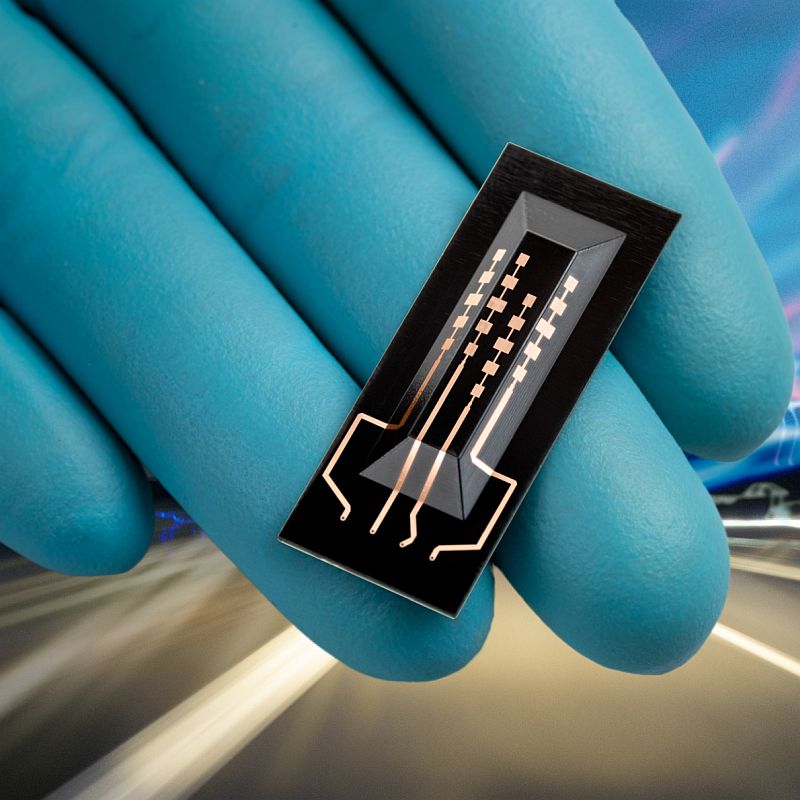Radar systems with a new design and AI support make self-driving cars safer – and cheaper
The combined radar expertise of Fraunhofer IZM is making the sensors needed for self-driving cars not just cheaper, but more reliable and accurate at the same time. The researchers joined a group of industry partners to design a radar system with an angular resolution of below one degree at 180° coverage. One advantage of the system: Autonomous cars need fewer than half of the radars they need nowadays. This feat was made possible by combining innovative electronics and packaging solutions with the power of AI to improve radar detection.
Enter a destination, strap in, and lean back while your car takes you where you want to go: Advances in technology and changes to traffic laws are promising to bring self-driving cars to Europe’s roads and highways. Although the technology has been slow to get off the ground, a Prognos analysis suggests that this trend is about to change: From 2030 onwards, the number of cars with some form of autopilot for highway and long-distance driving will increase markedly.1 There is lots left to do for the experts in science and industry, especially when it comes to empowering automatic vehicles to perceive and understand their environments. Their integrated sensor systems need to capture the world around them with enough reliability to detect even small objects at a distance of 100 meters and more and to distinguish accurately between human beings, animals, or physical objects.
Accurate sensors for greater safety
The Fraunhofer Institute for Reliability and Microintegration IZM has teamed up with InnoSenT GmbH, KSG GmbH, Creonic GmbH, and the University of Bielefeld to launch the “KI-Radar” project. Its mission: To develop a sensor system with an angular resolution below 1° at 180° coverage. Current radar sensors can achieve a resolution of 2° for an angle of 90°, which means that the new radar system doubles both the angular resolution and the radar’s coverage and can clearly detect and distinguish between objects at an angular distance of one degree or more.
On top of that, the proposed systems should ideally be covering an angle of around 90° on the horizontal plain as well, which would be a major step up from current systems and a real leap in the direction of genuinely safe autonomous cars. To achieve that feat, long thought impossible, of extending the radar’s coverage to 180°, the researchers are using three-dimensional antenna designs. But they have to contend with one essential problem: When the detection range is scaled up, radar sensors typically struggle with picking up fine details. In order to keep the resolution accurate enough when the range is extended, the researchers had to get creative. Dr Christian Tschoban, the Fraunhofer IZM Group Lead in charge of the project, explains their idea: “AI algorithms came to the rescue: We are using them to couple the data from individual radar sensors to substantially improve the system’s angular resolution.” After the individual components were developed by the project partners, two demonstration units were built and put to the test. Already during the first test run, the unit equipped with 3D antennas and built-in AI proved its capabilities: The system reliably detected objects at an angular resolution of below one degree. Nearing the end of the project, the second working unit was subjected to trials under real-world conditions. Fixed to a car, it also detected objects along the test route reliably and accurately.
Higher resolution, lower cost
With the greater range covered by the new sensors, cars have to be fitted with only six such systems to achieve true 360° coverage with enough certainty. As today’s autonomous cars would typically need around 16 sensors for the same purpose, this reduces the production costs for radar equipment to less than half the current cost. “KI-Radar” is a joint project with KSG GmbH, Creonic GmbH, and the University of Bielefeld. It is coordinated by InnoSenT GmbH and supported with €2.32 million in funding from Germany’s Ministry of Education and Research (funding ID: 16ES1018). On the consortium, the Fraunhofer IZM team was responsible for the development of the 79GHz radar frontend with its communication interface and the three-dimensional antenna. The researchers also miniaturized the system with the Institute’s embedding technologies to make it easier to integrate into regular vehicle designs. One unique feature of the project was its decision to approach both the hardware and the software in combination from the very beginning – a choice that paid off as it increased performance while helping to keep the costs low and make the physical system smaller.
(Text: Olga Putsykina)
Last modified:
 Fraunhofer Institute for Reliability and Microintegration IZM
Fraunhofer Institute for Reliability and Microintegration IZM
